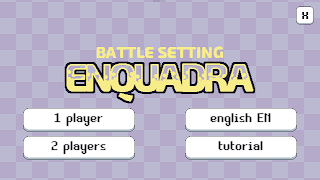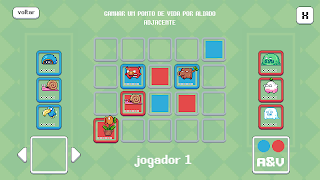the game had two big design problems that I tried to fix. the first one is that the initial positioning of the pieces made it trivial for the first player to get close to forming a line. the only way this wouldn't happen is if the opponent managed to remove one of their pieces. this made the game start to fast, in very few turns someone won or a piece got removed. there wasn't any time for the game to develop, even if it's still a naturally short game.
I corrected this by changing the position of the initial pieces, putting one on the corner. positioning a piece on the corner has interesting strategic considerations. it's impossible for the opponent to lock it, since there's no space on opposite sides, but it's also not as useful when forming a line, likewise becase it's not possible to put friendly pieces on both sides.
the initial positioning already brings strategic considerations, for instance, what piece already starts locked by the opponent and what pieces are free. where can you already start to form a line and what abilities will already be useful when you do it.
I was inclined to leave supportive pieces that recovered other's health initially locked, since at the first few turns few allies lost health, and tried to form an initial line with pieces that healed themselves, in case the opponent tried to block me with agressive pieces.
another necessary change was making aggressive pieces stronger. their abilities got inherited from Table Setting, however, the tendency in that game was for pieces to lose points constantly. since in Battle Setting the tendency is for them to loose points more slowly, but I still wanted the same threat of pieces getting removed, only in a more controlled manner, the aggressive powers had to get stronger to compensate.
the game is still very short. it's functional, but doesn't please me very much, I think I like Table Setting more, it is more dynamic with the instability of pieces getting constantly removed. despite changes in Table Setting successfully making it more tactical, I don't think it lasts enough for this to be well developed.
pieces losing one life when they get moved doesn't make that much of a difference I think. with this mechanic I wanted the player to have to balance the use of a piece with the recovery of its life points, but it ended up that enemie's aggressive abilities were always the biggest threat to a piece getting removed. however, this mechanic still has the benefit of bringing more weight to the decision of moving a piece. if the move wasn't useful, it only made the piece weaker, and this creates a certain weight. besides that, pieces that heal themselves gain the quality of not needing this consideration, since they can recover the points lost by movement right at that very moment, and end up being more flexible.
during development I had ideas to iterate this design even further that I intend to try out at some point this year. I think the locking mechanic is interesting, despite not making a whole lot of difference here, and starts to develop an interesting theme of neighbouring. the formation of a three piece line, that is, a piece and two neighbours, the locking of a piece for being framed by the opponent and abilities that hit adjacent tiles all create a dense and varied set of mechanics around the concept of adjacency. this is what I want to explore further and expand on the future.
 |
| final look of the title screen |




Sem comentários:
Enviar um comentário